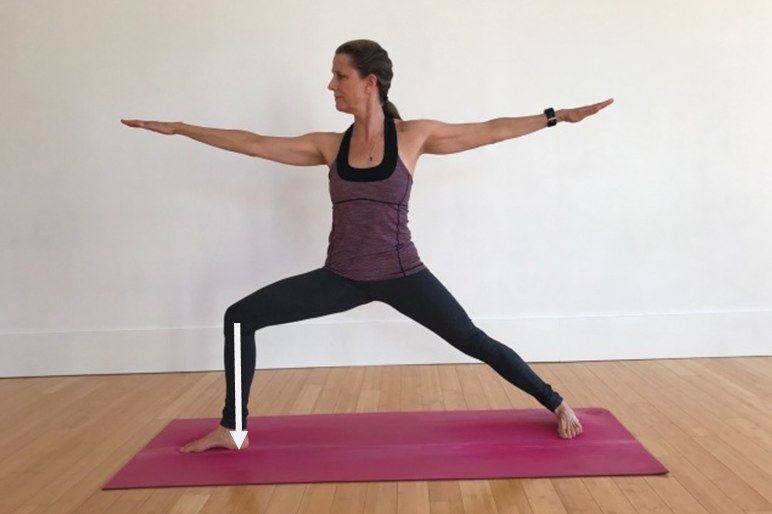If you have chronic pain in your knees, if they “snap, crackle, and pop” when you bend or extend them, or if they tend to hyperextend, you may have improper tracking or “dislocation” of the kneecap. This misalignment causes the most common kind of chronic knee pain and damage to the knee joint, which develops slowly over time. Yoga knee therapy might be able to help.
The most common source of knee pain is due to improper tracking of the knee cap or patella. The patella is a bone that protects the knee and helps to increase the contracting action of the quadriceps muscles in straightening the leg. It is supposed to slide in a groove in the femur as the knee bends and straightens. If this movement is not smooth and the kneecap goes off track (and it can), it can grind away at the cartilage underneath, destabilizing the knee. The ensuing pain is the most common reason for knee replacement surgery because people think that the cartilage is totally gone. It might not be completely gone and it can grow back, although it does so very slowly. However, if the mechanics of the knee is not improved, the rate of wear and tear will outpace the rate of healing.
The knee cap can move out of balance when there is an imbalance in one of the four muscles that make up the quadriceps group. All four of the quadriceps muscles connect to the kneecap and through a common tendon to the top of the lower leg, or tibia. It is a common occurrence for the inner quad muscle, vastus medialis, to be weaker than the outer one, vastus lateralis. When this occurs, it causes the kneecap to be pulled sideways by the stronger muscle.
To counter balance that, there is an exercise you can do:
Sit on the floor with your legs stretched straight out in front of you. Place a rolled up blanket or a mat under the back of the painful knee. In this supported position, the knee will be bent. Externally rotate the foot a few degrees so that the inner arch is facing towards the ceiling and the inner thigh is rotated up to the ceiling. This will focus your efforts on the inner quadriceps muscle called the vastus medialis. Smoothly contract the quadriceps to straighten the leg. Hold the contraction with the heel off of the floor for about three seconds before gently lowering the heel back down to the floor. Repeat this for 10 reps. Rest and repeat this exercise 3 times. If you have access to a gym and a leg extension machine, you can do this exercise that way, too. Sometimes the weight in the machine is not light enough if you are in pain, in which case do the exercise over the rolled blanket until your knee becomes less painful and it gains strength.
How does this relate to your yoga poses? The first way is your ability to straighten your leg and lift the kneecap in straight leg poses and the second way is to pay attention to the alignment of your knee over the ankle in bent knee poses.
For the straight leg version, this can be done in stages. First, do the exercise above where you straighten the leg over a rolled blanket or mat. Then try to straighten the leg while sitting in Dandasana, or staff pose. Place the leg straight against the floor and contract the quad, straightening the leg. Make sure you keep the heel grounded otherwise you are hyper-extending the knee. Can you lift your kneecap? This is the easiest way to learn to lift the kneecap. Next try to lift your kneecap in Prasarita Padottanasana (Wide Legged Forward Fold) Then try it in Trikonasana, (Triangle Pose). It is harder to lift the kneecap of the front leg in Trikonasana but it can be learned and it is a safer way to practice straight leg poses.
For the bent knee poses it is important that your shin is vertical. It doesn’t really matter how deep of a bend you have. That is dependent on your strength and flexibility. It is more important that you knee is over your ankle. This needs to happen in two planes: the front plane and the side plane.
In the front plane:
These three images show the relationship of the knee and the ankle. The picture on the left shows correct alignment with the knee lined up over the second toe. The picture in the middle shows the knee pulling to the pinky toe side of the foot. This works the outer quad, vastus lateralis, which does not help strengthen the inner quad. The picure on the right shows the knee caving in toward the big toe side of the foot. This creates wear and tear on the inner knee and further weakens the inner quad, vastus medialis.
In the side plane:
From the side view, the knee should be over the ankle. Often the knee is behind the ankle which creates compression in the knee joint. Rarely is the knee past the ankle as this is harder to hold and it creates a lot of pressure in the knee.
As you can see, practicing yoga can be very beneficial for your knees if you pay attention to your alignment. It is important to have a teacher who is aware of these subtleties and can help you work to enhance the natural therapeutic benefits of the poses.






